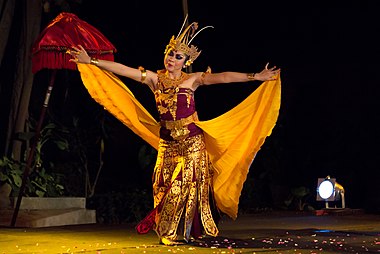Talk:Cendrawasih dance
A fact from Cendrawasih dance appeared on Wikipedia's Main Page in the Did you know column on 20 November 2014 (check views). The text of the entry was as follows:
|
| This article is rated Start-class on Wikipedia's content assessment scale. It is of interest to the following WikiProjects: | |||||||||||
| |||||||||||
Obscure
[edit]- originated from I Gde Manik Is that a district of Bali? an explanatory phrase is needed for the English-language reader.--Wetman (talk) 00:19, 21 November 2014 (UTC)
- "I Gde" is a Balinese honorific, so clearly a person. Changed to "designed by". — Crisco 1492 (talk) 02:58, 21 November 2014 (UTC)
- Significantly different Different in what way? How is this difference significant?--Wetman (talk) 00:19, 21 November 2014 (UTC)
- Differences not expanded on in source. — Crisco 1492 (talk) 02:58, 21 November 2014 (UTC)
File:17 Years of Sekar Jepun 2014-11-01 44.jpg and subsequent to appear as POTD
[edit]Hello! This is a note to let the editors of this article know that File:17 Years of Sekar Jepun 2014-11-01 44.jpg and subsequent will be appearing as pictures of the day on June 10, 2017. You can view and edit the POTD blurb at Template:POTD/2017-06-10/1 and subsequent. If this article needs any attention or maintenance, it would be preferable if that could be done before its appearance on the Main Page. Thanks! — Chris Woodrich (talk) 02:01, 28 May 2017 (UTC)
Inspired by the courtship dance of the bird of paradise, the dance takes the form of a mating ritual. Two women dancers don Pandji-style headdresses with feathers stuck in them, as well as long flowing scarves or skirts with a pink stripe. The skirts serve as the tails of the birds of paradise, and when held their fluttering gives the impression of wings in flight, as shown here.
Other movements: Tail hanging, Courting movementsPhotograph: Chris Woodrich



